Video
You’d be amazed at what you’ll see if you simply slow down and look up at the stars.
I spent a few nights capturing star time-lapses last weekend in Colorado. It was 20 to 30 degrees f. which made waiting 2 to 3 hours a bit rough but it was well worth it. We all could likely benefit from looking up at the stars instead of down at our phones all the time.
elemotionphoto
307 notes
·
View notes
Text
learning that most trees do not derive from a single lineage but actually only look and function superficially similarly due to convergent evolution is one of the most fucked up things i’ve ever learned and i will never be the same person as i was before i learned that
106K notes
·
View notes
Text
Science communications has to change.
It does. It’s important that we change now. We should have done it before.
And I don’t know what changes need to be made but I do feel like science communications and outreach has a few really glaring problems.
1. We mostly talk to children. That’s fine. They are the future. But they aren’t the now and when we don’t get their parents engaged to, we’re asking them to clean up a mess when they’re old enough. And when I say children, I really mean children. I don’t know the last time I was at an outreach event that focused on high schoolers or was made for a high school audience.
2. We’re mostly talking to people who will already be fairly well educated. That’s fine to. But we’re missing people who either have little interest in actively investing in education and people who don’t have access to it. We’re mostly getting contact with people who are already in school.
3. We are talking to people who already agree. We are preaching to the choir. That makes sense – they are who shows up. I don’t know how to talk to people who already think I’m wrong or a waste of tax payer dollars but I would love to find out. Negin Farsad might have some tips, though.
4. We exclude people. We do. We often implicitly exclude religious groups. We often implicitly exclude people who don’t have a higher education. My mother, even, was nervous about having dinner with my undergraduate advisor because, “[she doesn’t] have a doctorate, [she doesn’t] know how to talk to somebody that smart.” I don’t know how to stop that impression but I would love to.
5. Maybe, too many of us are career scientists. That’s fantastic – we have a job we are passionate about. But…then it is a little easy to write off our excitement. I’m not always that impressed by how cool math is when a mathematician gets excited about it. But if my barista got excited about a proof – wow, that must be a really cool proof, right!?
6. We don’t always have the communication skills. This is obvious because the seminars I go to are not as exciting to me as a TEDTalk, even if the subject matters to me more. We need to hone those skills. For me, I’m hoping to take improv classes. Write more. Try different things. But we need to include professional communicators or theater departments or artists in our efforts.
I am 23. I am not a seasoned science communicator. I might not even be a seasoned communicator. I can’t find the answers to all of these but I know they are problems.
9K notes
·
View notes
Photo
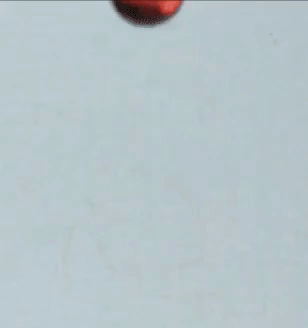
Dancing droplets
When this water droplet falls and smacks the surface below, it doesn’t just bounce back up. It pirouettes in the air. The droplet gyrates likes this because of the four slits on the surface. Aided by surface tension, these slits guide the droplet to expand into four directions upon impact instead of expanding into all directions evenly. When the droplet contracts as it bounces back up, it follows the curves of the slits, producing the spinning motion. The labs of Xi-Qiao Feng at Tsinghua University and Yanlin Song at the Chinese Academy of Sciences collaborated to research this type of patterned surface, which they made by coating a plate with a super water-repellent polymer 1H, 1H, 2H, 2H-perfluorodecyltrimethoxysilane and then etching in the four slits with ultraviolet light. The researchers hope this surface’s ability to convert translational motion to rotational motion could be used in inkjet printing or potentially to harvest energy from falling raindrops. —Manny Morone
Credit: Nat. Commun. 2019, DOI: 10.1038/s41467-019-08919-2
Do science. Take pictures. Win money. Enter our photo contest here.
Related C&EN Content:
Wind And Rain Power Smart Windows
Superrepellent surface rejects even the ‘stickiest’ of fluorinated solvents
Wrinkling Teflon creates a superhydrophobic surface
224 notes
·
View notes
Text
Things Disaster Movies Always Get Wrong
We all love disaster movies! The cool special effects, the underdog stories, the underlying themes of hope. As cool as they are, they do tend to use misconceptions about natural disasters. This normally wouldn’t be an issue since Hollywood will always embellish but it’s important to know the true science behind these phenomena should you ever encounter them.
1) Pyroclastic flows will kill you almost instantly, you cannot survive a direct hit
Movies guilty of this: Jurassic World: Fallen Kingdom, Dante’s Peak
Pyroclastic flows exceed 100km/h and reach temperatures over 1,000°C. You definitely cannot outrun it in either car or on foot. The boiling hot toxic gas, ash, and lava in the flow will kill you instantly and pummel your smoking corpse into oblivion. Sorry, Chris Pratt.
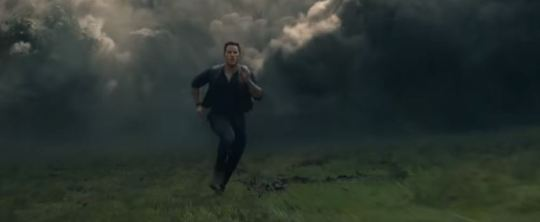

2) Tsunamis do not crest, they are more like a sudden flood than a wave
Movies guilty of this: Literally any movie with a tsunami ever
Tsunamis are massive and sudden floods caused by the displacement of ocean water due to earthquakes or massive landslides. They’re not tidal waves and thus do not crest. It’s poetic, but inaccurate.

3) Hail is always spherical and doesn’t fall in big cinder blocks of ice
Movies guilty of this: The Day After Tomorrow
Hail can get quite large and can definitely be fatal, but they are exclusively spherical. Hail is formed by water droplets cycling through the updrafts of a thunderstorm and the rotational movements make the resulting hail a ball.

Looks more like a stage hand is throwing the remains of an ice swan than a hail storm
4) You cannot freeze instantaneously. Not even in space.
Movies guilty of this: The Day After Tomorrow, Geostorm, The Cloverfield Paradox, Sunshine
Space, and certain places on Earth, can get exceedingly cold. The coldest temperature ever recorded on Earth was −89.2 °C. That’s damn cold. But you still wouldn’t flash freeze into a peoplesicle within mere seconds. Intense cold can kill you quickly if you’re completely exposed but it would still take time before your body would be a thoroughly frozen chunk of meat. As for space, it can get quite cold, but it’s also an empty vacuum. There’s nothing around you but empty void, which means there’s also nothing to transfer your body heat away from you. Without convection, your body heat would be lost via radiation and that can take a long time.

5) Earthquakes over 10 on the Richter scale are physically impossible on Earth.
Movies guilty of this: 10.5
You would need a massive fault line to carry that sort of energy. Something on the scale of going through the earth’s core. Which does not exist . Even then, if such an earthquake would occur, the planet would literally explode.A 15 magnitude earthquake would release energy on the magnitude of 1x10^32 joules. That, coincidentally, is the same amount of energy contained in the gravitational binding of the Earth. Simply put, anything greater than 9.9 on the Richter scale is impossible and would cause the Earth to explode.
6) California will and can not sink into the Pacific like a big slab, and it can’t break away from the rest of the US.
Movies guilty of this: 2012, 10.5
Most movies cite the San Andreas fault as the reason for the cleavage, but even this isn’t enough. The San Andreas fault is a transform fault, meaning the North American plate and the Pacific Plate are slowly horizontally grinding past each other, not pushing away. As California is a part of the greater Pacific plate, it literally could not snap free from it to “sink into the sea”. Because if the entire tectonic plate underneath California where to flip over and sink then the entire ocean would drain away into the mantle.
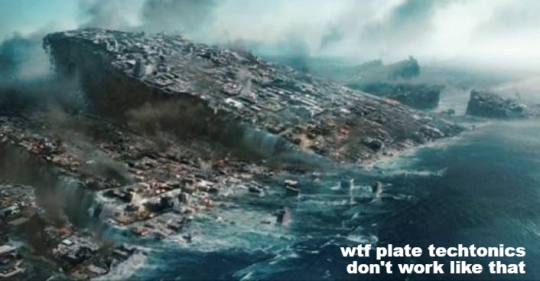
7) You can’t sink in lava. You also can’t stand near it without being burned.
Movies guilty of this: Volcano, Lord of the Rings: Return of the King
Lava is molten rock, and is incredibly dense. In fact, it’s three times as dense as humans, who are mostly water. If you were to cannonball into a lava pit, you would dip in a bit before bouncing to the top and floating. You would also burn up and die super quickly. Because fresh lava can exceed 1,200°C! Even standing a couple feet away from a lava flow, you would feel the intense heat radiation. You would lose your eyebrows and probably the top layer of your skin if you stood too close. There’s a reason why volcanologists wear protective suits. Sam and Frodo would have been roasted.

71K notes
·
View notes
Text
Since I’m not seeing her name nearly enough on the press, let’s give the attention Katie Bouman deserves. Thanks to her, we are now possible to see the first ever image of a black hole, something that people talked 200 years ago for the first time. It’s no longer a myth.
We are girls and we can be whatever we want to be. Einstein would be proud of you, Katie. Thank you!


Here you can see a huge stack of hard drives she used for Messier 87’s black hole image data.
139K notes
·
View notes
Text
New aerogel can withstand extreme conditions in space

The aerogel could be used to coat spacecrafts due to its resilience to certain conditions.
Researchers have created a new extremely light and durable ceramic aerogel. The material could be useful for applications like insulating spacecraft because it can withstand intense heat and severe temperature changes.
The aerogel comprises a network of tiny air pockets, with each pocket separated by two atomically thin layers of hexagonal boron nitride. It’s at least 99% space. To build the aerogel, Duan’s team used a graphene template coated with borazine, which forms crystalline boron nitride when heated. When the graphene template oxidises, this leaves a ‘double-pane’ boron nitride structure.
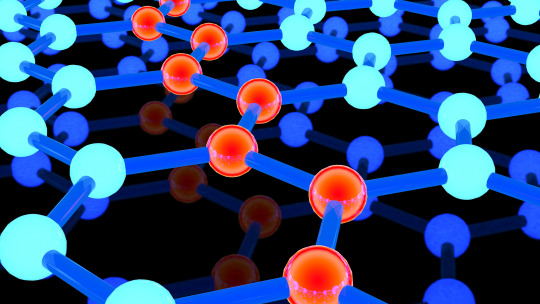
The basis of the newly developed aerogel is the 2D structure of graphene.
‘The key to the durability of our new ceramic aerogel is its unique architecture,’ says study co-author Xiangfeng Duan of the University of California, US.
‘The “double-pane” ceramic barrier makes it difficult for heat to transfer from one air bubble to another, or to spread through the material by traveling along the hexagonal boron nitride layers themselves, because that would require following long, circuitous routes.’
youtube
How does Aerogel technology work? Video: Outdoor Research
Unlike other ceramic aerogels, the material doesn’t become brittle under extreme conditions. The new aerogel withstood 500 cycles of rapid heating and cooling from -198°C to 900°C, as well as 1400°C for one week. A piece of the insulator shielded a flower held over a 500°C flame.
To read the full article, by Maria Burke, for free in C&I, the members’ magazine for SCI, click here.
73 notes
·
View notes
Photo
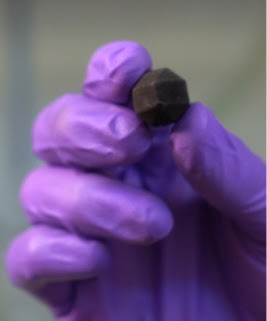
Odd reaction creates a stir in the lab: Rice University researchers find using certain stir bars can create laboratory errors
The stirrers that mix cream into your coffee probably don’t make much difference to the drink. But in a chemistry lab, it turns out using the wrong stirrer can skew the science.
[…]
Rice University scientists have determined that stir bars made of PTFE, more commonly known as Teflon, can introduce errors into a standard lab reaction used to manipulate the properties of carbon or boron-nitride nanotubes.
Stir bars are pellet-like rods of ferromagnetic metal covered in PTFE that sit in the bottom of a beaker and are turned by a rotating magnetic field. They allow a solution to be mixed in a closed flask without manual stirring.
Read more.
1K notes
·
View notes
Text
That rabbit/hare post is messing me up. I’d thought they were synonyms. Their development and social behavior are all different. They can’t even interbreed. They don’t have the same number of chromosomes. Dogs, wolves, jackals, and coyotes can mate with each other and have fertile offspring but rabbits and hares cant even make infertile ones bc they just die in the womb. Wack.
339K notes
·
View notes
Text
what’s your strangest belief that doesn’t intersect (except in the most generous hot take way that anything can) with politics/culture war type stuff?
555 notes
·
View notes
Text
My math professor is a fool and I love him
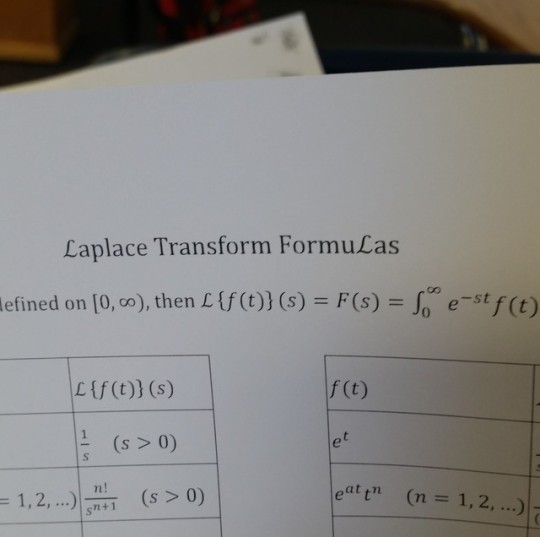
4 notes
·
View notes
Text

this part of the into the spider verse script sent me into a fit of uncontrollable laughter that i had to hold in as quietly as possible to not wake my sleeping mom and aunt, to the point that i almost choked in a hotel room 400 miles from home with my mom and aunt snoring away obliviously as i lost all sense of awareness, drowning in unheard laughter, face contorting into the ugliest grin i’ve ever made to the point i felt pain, recovering slowly slowly slowly until i could breathe again.
and then i reread it and the cycle begins anew.
11K notes
·
View notes
Text
The Transgender Scientists That Changed the World of Science.
As this week is Transgender Week of Awareness (12th - 19th November) I felt it was a good time to bring awareness to some of the more well-known transgender scientists that changed science. Trans people have always been apart of scientific discovery but like most minorities within STEM have struggled to gain recognition for their contributions.

Alan Hart (1890–1962) | Epidemiology

A Yale-trained epidemiologist, radiologist and physician, Hart one of the first trans men in the US to undergo a hysterectomy and live openly as a man, taking testosterone treatments when they became available after World War II. Hart also become a prominent figure in the fight against tuberculosis, which at the time was the leading cause of death in Europe and the US. He graduated with a medical degree in 1912 and later in 1928 received a master’s degree in radiology. He eventually became an expert on tubercular radiology and published several articles on X-ray medicine and its use in the detection of tuberculosis and went on to gain another master’s degree in public health in 1948.
Hart then served as the director of hospitalization and rehabilitation at the Connecticut State Tuberculosis Commission and continued to dedicate his professional life to tuberculosis research.
Ben Barres (1954 - 2017) | Neuroscience

Barres was the first openly transgender scientist in the National Academy of Sciences in 2013 and talked openly about his experience of sexism pre-transition and advocated for better gender equality within science. Barres research focused on the interaction between neurons and glial cells in the nervous system. Barres showed that the gila, which at the time were often dismissed by neurologists as simple the support structure for the brain, had important functions in helping neurons to mature and producing connections between memory and learning functions. This discovery revolutionised neruobiologists understanding of the brain.
Barres also went on to mentor many young scientists and repeatedly spoke about the systemic barriers and biases that kept marginalised groups such as women, poc and LGBT people, from succeeding or furthering their careers and research within science.
Sophie Wilson | Computer Science
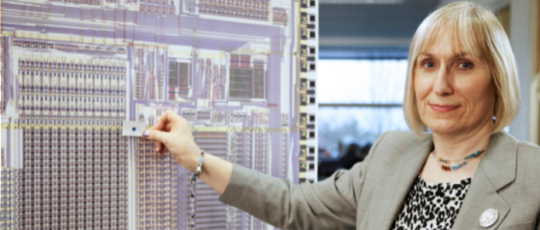
Sophie Wilson is a British computer scientist who is known for designing the Acorn Micro-Computer, the first computer sold by Acorn Computers. She also designed the instruction set of ARM processor which is used in 21st-century smartphones and is considered one of the most important woman in tech history.
Lynn Ann Conway | Computer Science

A pioneer of a number of technological advancements and inventions, Conway is an American computer scientist, electrical engineer and inventor. She first worked at IMB in the 1960′s designing a super computer and is credited with the invention of generalised dynamic instruction handling, now used by modern computer processors in order to improve performance. She was fired after she revealed her intention to transition and was denied access to her children.
After she transitioned she restarted her career and authored the Mead & Conway revolution in VLSI design, that was considered groundbreaking work that quickly become a standard textbook in chip design.
Joan Roughgarden | Biology

known for her critical studies on Charles Darwin’s theory of sexual selection and LGBT biology, Roughgarden is an American ecologist and evolutionary biologist, having published over 180 scientific articles and books. Roughgarden has carried out ecological studies on barnacles, Caribbean lizards but is most known for her published book critiquing Darwin’s sexual selection theory based on the fact it fails to answer and consider animals which do not follow traditional sex roles of intrasexual and intersexual selection. She was met with bitter and vitrioli criticism from other scientists for publishing such views, to which she was not surprised.
Roughgarden went on to publish a second book further pointing out over 26 phenomena which the current sexual-selection theory does not explain, and instead suggests the social-selection theory. She continues to make analytical studies that social selection is a more credible explanation.
Honorable mentions to these transgender scientists:
Audrey Tang
Angela Clayton
Kate Craig-Wood
Mary Ann Horton
Christa Muth
And to all the unseen and unnamed transgender scientists.
23K notes
·
View notes


